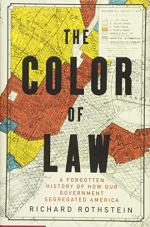
|
| Name: _________________________ | Period: ___________________ |
This test consists of 15 multiple choice questions and 5 short answer questions.
Multiple Choice Questions
1. After the post-war housing shortage ended, what does Rothstein say the real estate industry lobbied for?
(a) Excluding black workers from skills positions.
(b) Making sure public housing was a place of poverty and crime.
(c) Using subsidies to remedy historic injustices in housing.
(d) Limits on black contractors.
2. What else was covered beside who could buy a house in a racially restrictive covenant?
(a) Who could visit the house as guests.
(b) What color the house could be painted.
(c) What religion the residents would practice.
(d) What kinds of business could be run out of the house.
3. Why was Gerald Cohn of San Francisco investigated by the FBI?
(a) For selling his house to a black family.
(b) For voting against his neighborhoods racially restrictive covenants.
(c) For lying to appraisers.
(d) For offering a private mortgage to a black family.
4. When did the Public Works Administration create jobs and housing for whites only?
(a) 1933.
(b) 1921.
(c) 1917.
(d) 1928.
5. What is de facto segregation?
(a) Government policies keeping races apart.
(b) White supremacist threats keeping races apart.
(c) Geographical features keeping races apart.
(d) Private decisions keeping races apart.
6. How did the HOLC change the face of mortgages in 1933?
(a) They made them shorter.
(b) They amortized them.
(c) They extended them to black families.
(d) They stopped amortizing them.
7. What does Rothstein say the FHA’s appraisal standards included?
(a) A reparations requirement.
(b) An integration requirement.
(c) A fair share requirement.
(d) A whites-only requirements.
8. When did the PWA end?
(a) 1917.
(b) 1937.
(c) 1957.
(d) 1982.
9. What ethnic group was included in prohibitions of sales in Brookline, MA, alongside African Americans?
(a) Irish.
(b) Spanish.
(c) Germans.
(d) Greek.
10. Why were blacks primarily prevented from buying houses?
(a) Because communities refused to admit them.
(b) Because the government would not back mortgages for their homes.
(c) Because they could not afford them.
(d) Because private developers refused to sell to them.
11. How does Rothstein characterize the nature of the sales when blockbusters sold to African Americans?
(a) Straw man sales.
(b) Cash sales.
(c) Contract sales.
(d) Deferred sales.
12. Who does Rothstein say led the movement to develop zoning ordinances in every municipality to separate the races?
(a) Warren Harding.
(b) Harland Bartholomew.
(c) Herbert Hoover.
(d) Harold Ickes.
13. What does Rothstein say was behind the fear of property values falling?
(a) Fear of violence.
(b) Guilt.
(c) Racism.
(d) Fear of contagion.
14. What did the state of Montana ban in 1909?
(a) Black business ownership.
(b) Selling homes to African Americans.
(c) Intermarriage.
(d) Employing African Americans.
15. When was it that the first city concentrated blacks in neighborhoods based on race?
(a) 1904.
(b) 1918.
(c) 1889.
(d) 1910.
Short Answer Questions
1. What position did Frederick Law Olmsted Jr., America’s pre-eminent landscape architect, take on integration in housing?
2. What did Harland Bartholomew do as planning engineer for St. Louis, MO?
3. What does Rothstein say black families were unprepared to do as a consequence of purchasing from blockbusters?
4. What kind of developments was New Orleans Mayor DeLesseps Morrison told that the FHA wanted?
5. How did the FHA’s own 1948 report characterize the black families’ conditions in neighborhoods they could not move out of?
|
This section contains 564 words (approx. 2 pages at 300 words per page) |

|




